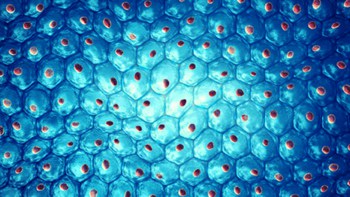
An imaging technique originally developed to detect how light scatters off red blood cells has been improved by researchers in France so that it can now safely image coronary blood circulation in donor hearts during ex situ heart perfusion (ESHP), a procedure used for heart preservation and screening. The new technique, known as laser speckle orthogonal contrast imaging (LSOCI), enables noninvasive high-resolution imaging of all the peripheral blood vessels of the heart in real time, and could provide valuable information to doctors on the quality of an organ to be transplanted.
“Such dynamic speckle technology has been around for a long time,” explains team leader Elise Colin from Paris Saclay University and the start-up ITAE Medical Research, “but it is normally applied to stationary objects. We had no idea if we would be able to obtain images of blood activity at all when we applied it to an object with significant movement, like a beating heart.”
Graft failure following heart transplantation surgery can come about because of abnormalities in the donor organ, such as coronary artery disease. The risk of these abnormalities increases with age or in patients with pre-existing heart conditions. Careful screening for such conditions is thus vital to determine whether an organ is eligible for transplantation.
In recent years, ESHP has enabled assessment of the heart outside the body. Here, doctors monitor the performance of a donor heart after oxygenated nutrients have been supplied to it via its blood vessels. The problem is that conducting coronary angiography during ESHP (to screen for coronary artery disease) can damage the heart. Alternative imaging techniques to identify abnormal blood flow in donor organs are thus needed.
Analysing speckle images
The LSOCI technique used in this study analyses speckle images, which result from the many constructive and destructive interferences that occur when the surface or volume of an object is illuminated with coherent light such as that from a laser. In these images, researchers look at the speckle contrast parameter, which Colin describes as a type of “blur function”. “This is all the more important when the scatterers producing the signal are in motion, as is the case of red blood cells, for which this technique was developed,” she explains.
Colin and colleagues have now improved LSOCI to observe small blood vessels in the heart. The new method, which they detail in the Journal of Biomedical Optics, is able to analyse blood flow in the organ using a specific polarimetric filter that favours the interactions between light waves that have undergone more multiple scattering. These interactions generally occur at depth in the blood vessels, meaning that surface light scattering is suppressed. The speckle patterns produced are therefore mainly produced by multiple scattering of moving red blood cells inside the vessels.
In the case of an organ that moves periodically, like the heart, researchers need to be able to calculate the blur function without it being affected by the overall motion of the organ. To do this, Colin and colleagues developed an algorithm that allowed them to select the images that have the least movement between them, along different periods of heartbeat.
“It is important to understand that the resulting images do not contain the same information as a radiometric image, for example,” she tells Physics World. “The images produced are motion images of red blood cells, and when the heart is made to stop beating, no vessels are visible in the image.”
Valuable information for doctors
The images obtained represent the vasculature of the heart at different time points and by analysing a sequence of these images, the technique can be used to visualize vasculatures as small as 100 µm in a matter of seconds. It could thus be used to identify myocardial perfusion abnormalities indicative of underlying heart conditions, say the researchers.

Ultrathin e-tattoo provides continuous heart monitoring
“This information is valuable for doctors so that they can assess the quality of an organ to be transplanted,” says Colin. “Such information is important since it allows us to consider using grafts with less stringent age limits, for we now have a post-evaluation method to assess the health condition of these donor organs. An indirect consequence of this is that it increases the number of transplantation possibilities.”
Colin and colleagues are now in the process of filing a patent for a method of temporal calibration based on their technique, but say that they still need to validate the concept specifically for their image enhancement method. “Once this has been done, we will be able to ensure that doctors have access to an image with a quantified medical index, meaning that the values are comparable over time from one system to another,” says Colin. “We would also like to continue our research on polarization optimization. This would allow us to achieve the best contrast and move towards obtaining three-dimensional information.”



